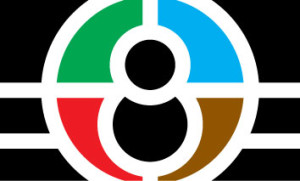
Species name: Vohra (juveniles, species in general), Varga (adult males), Vayra (adult females)
Full name: (Nitropneic) Panvrekavok Panvok Vohra
Average dimensions:
Average Height: 1m (Vohra), 1.7m (Varga), 3.5m (Vayra)
Average Length: 1.4m (Vohra), 3.4m (Varga), 3m (Vayra)
Description: Vohra are small, round, insectoid bipedal beings, with heads almost as large as their bodies, long tails and short arms and legs, which they can pull in towards their bodies to make themselves spherical. They have four long canine teeth, their upper canines connecting to a solid chitin headplate. Their necks are somewhat long and they can extend their heads up to 50cm away from their bodies. Vohra have large eyes designed for seeing in the dark, wide nostrils for picking up scents but no external ears – they are hard of hearing and rely on telepathy and pheromones to communicate. They have three claws on their hands and feet and are powerful diggers. Vohran tails are in fact umbilical cords, normally kept straight but are capable of opening up into a suction cup-like fan, which are kept throughout their lives and with which they hang from the ceilings of their small, individual canister-like homes.
Vayra, adult females, are physically somewhat similar and are many times the size of the juveniles, but their jaws are incredibly huge, as their jaws also function as the path to their genitalia – Vayra lay eggs via their enormous mouths. Their bodies are incredibly bloated and many often cannot move. Vayra also have many more tails, which they use to grab things their arms can’t reach.
Varga are vastly different, having a lizard-like body and running on all fours. Their jaws are long but wide and they have vastly long tongues, up to 2m in some cases, which curl up inside their skulls. Varga are covered in heavy armour all over and their limbs are much more muscular than their juvenile or female forms. They lose their telepathy and often their ability to speak, but they gain incredibly acute senses.
Colouration: Vohra come in all sorts of colours, with grey headplates and light grey necks and tails. All Vohra inherit their colours from their Vayra mother, with a secondary colour coming from their Varga father.
Abilities: All Vohra have high level elemental powers of all types except Life and Time. They are well versed in their elemental use. The strongest elemental users are Kalsa Warriors, followed by Vayra. They also have low-level telepathy – basic conversation-level mind-reading, but only among siblings and members of the same nest. Their elemental powers mean that most Vohra are physically very weak, and injuries take a long time to heal.
Varga can’t use elemental abilities, but are heavily armoured and incredibly durable. They also heal quickly from light injuries such as cuts and scratches.
Temperament: When undisturbed, Vohra are docile beings who calmly and almost silently work their jobs within their nest. When they are threatened, they swarm together and neutralize the problem as soon as possible, assuming it has not already been dealt with by a Kalsa Warrior.
Vayra are cruel and manipulative, always looking for the best way to keep their nest (and any lower Vayra) completely under their control.
Due to their ill-treatment, Varga are insane monsters and will frenzy at the sight of any other living being apart from another Varga.
Diet: All Vohran nutrition comes directly from farms within their nests that produce various foods. The most common food is milowheat, a sweet, carbohydrate-filled crop similar to normal wheat; Vohran honey, which is made from pollen taken from giant flowers that grow within the nests and mixed with the fermented and otherwise inedible parts of milowheat; and sitaki, a plant much like corn, which is broken down to make various syrups. Younglings are fed milk taken directly from the breasts of lower Vayra in a nest. Vayra eat a special concoction made from the mixing of Vohran honey and fermented sitaki. Varga are omnivores and will eat whatever they are given, but they prefer flesh.
Life Cycle: The Vohran life cycle is extraordinary, unlike that of most species. Younglings are born inside cylindrical containers made by other Vohra in the nest, and they connect to the ceilings of these containers via their tails, which fan out at the tip and act as their umbilical cords. While in this state, they are fed Vohran honey and milk and are taught very basic education via telepathic links to their Vayra queen. After 2 years in this state, they become strong enough to walk and their containers are moved to the nursery areas. Younglings are arranged by element then taught how to use their powers, before being taught whatever job they’re destined to do within the nest. They reach full size and start working their jobs at the age of 4.
Younglings with certain strengths are taken away at birth and trained to become Kalsa Warriors, the main defence of any Vohran nest. Kalsa Warriors start work at the age of 6, due to the extra training needed.
The majority of Vohra remain in their young forms for all their lives. When they reach 50 years of age, they undergo gender testing. Those who gender male generally have three choices – the majority are neutered and spend the rest of their lives serving within their nests. Males with genetic potential are taken away and separated from the rest of the nest until they undergo their painful transformation into Varga, at which point they are shackled up and locked away. Any who are female are trained to become Vayra, are given a company of 20 ungendered (or neutered) Vohra and their choice of one of the enslaved Varga in their home, then are sent out to form a new nest, although in recent years it has become more common for a new Vayra to remain within their home nest.
The transformation from Vohra to Vayra is slow and painless, happening over 2 weeks. The transformation from Vohra to Varga is incredibly painful and happens over the course of a few hours.
Some Vohra are known to become Varga before the age of 50 and these Varga are captured then abandoned on ‘dump worlds’ where they are left to fend for themselves. The majority of these free Varga die within the year, generally due to isolation and competition between them and the Thanatians and Banikans whose lands they are intruding on, but those who make it will form small packs and try and live peacefully on their own.
Culture: There is little culture among the Vohra, as they work long and hard to maintain their nests. What culture they have comes from the Kalsa Warriors, who have made self-defence into an art and in their free time, they show off to impress off-duty Vohra and their Vayra.
Varga have no culture at all, but are known to gather shiny things. Enslaved Varga arrange their collection of ‘shinies’ in patterns around their cells, while free Varga will simply hoard them.

Government: All Vohra in a nest are ruled by one Vayra, the Vayra Queen, who is often the first Vayra in a nest and almost always the oldest and wisest. Queens within a certain distance of once another form alliances known as Queenships and warn each other of danger and often discuss various issues that may be affecting their nests. All the Queenships come together every 10 years and elect a Queen Prime, who effectively rules over all Vohra, but generally mainly deals with external affairs. Normal Vohra have little say within a nest, and when a Vayra is unavailable, the next in line is the leader of the nest’s team of Kalsa Warriors.
Technology: Vohran technology is partly mechanical, partly organic, all built within their nests. Transportation is done by mine carts and tracks or by simply walking or rolling along the ground. Their medical technology is very impressive, as they can diagnose any Vohra’s illness or injury and treat it within a few days. Otherwise, their tech is similar in intelligence to that of humans and Vreka.
Economy: The Vohra have a completely self-contained society and thus have no desire to really trade with other races. Despite this, they do trade some of their produce for non-essential items and luxuries.
Some Varga have been observed trying to trade shiny items for food or land with Thanatians and Banikans, although often with little success.
